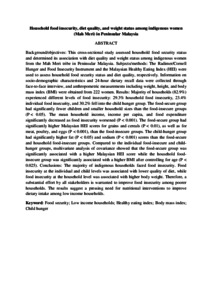Citation
Chong, Su Pei and Appannah, Geeta and Sulaiman, Norhasmah
(2018)
Household food insecurity, diet quality, and weight status among indigenous women (Mah Meri) in Peninsular Malaysia.
Nutrition Research and Practice, 12 (2).
135 - 142.
ISSN 1976-1457; ESSN: 2005-6168
Abstract
Background/objectives: This cross-sectional study assessed household food security status and determined its association with diet quality and weight status among indigenous women from the Mah Meri tribe in Peninsular Malaysia. Subjects/methods: The Radimer/Cornell Hunger and Food Insecurity Instrument and the Malaysian Healthy Eating Index (HEI) were used to assess household food security status and diet quality, respectively. Information on socio-demographic characteristics and 24-hour dietary recall data were collected through face-to-face interview, and anthropometric measurements including weight, height, and body mass index (BMI) were obtained from 222 women. Results: Majority of households (82.9%) experienced different levels of food insecurity: 29.3% household food insecurity, 23.4% individual food insecurity, and 30.2% fell into the child hunger group. The food-secure group had significantly fewer children and smaller household sizes than the food-insecure groups (P < 0.05). The mean household income, income per capita, and food expenditure significantly decreased as food insecurity worsened (P < 0.001). The food-secure group had significantly higher Malaysian HEI scores for grains and cereals (P < 0.01), as well as for meat, poultry, and eggs (P < 0.001), than the food-insecure groups. The child-hunger group had significantly higher fat (P < 0.05) and sodium (P < 0.001) scores than the food-secure and household food-insecure groups. Compared to the individual food-insecure and child-hunger groups, multivariate analysis of covariance showed that the food-secure group was significantly associated with a higher Malaysian HEI score while the household food-insecure group was significantly associated with a higher BMI after controlling for age (P < 0.025). Conclusions: The majority of indigenous households faced food insecurity. Food insecurity at the individual and child levels was associated with lower quality of diet, while food insecurity at the household level was associated with higher body weight. Therefore, a substantial effort by all stakeholders is warranted to improve food insecurity among poorer households. The results suggest a pressing need for nutritional interventions to improve dietary intake among low income households.
Download File
![[img]](http://psasir.upm.edu.my/74521/1.hassmallThumbnailVersion/Household%20food%20insecurity%2C%20diet%20quality%2C%20and%20weight%20status%20among%20indigenous%20women%20%28Mah%20Meri%29%20in%20Peninsular%20Malaysia.pdf)  Preview |
|
Text
Household food insecurity, diet quality, and weight status among indigenous women (Mah Meri) in Peninsular Malaysia.pdf
Download (92kB)
| Preview
|
|
Additional Metadata
Actions (login required)
 |
View Item |

